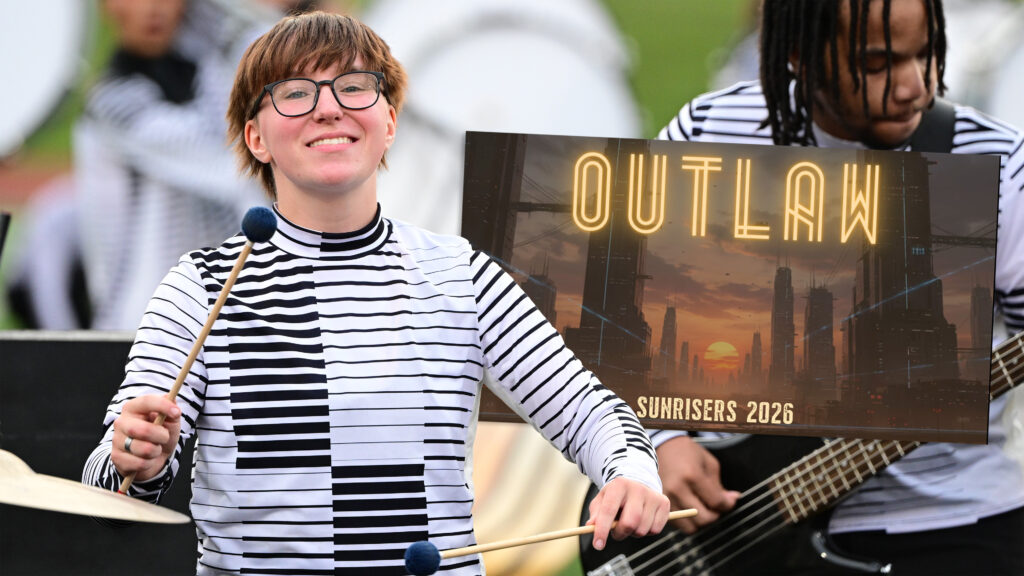In 1977, the Drum Corps International World Championships went to Denver for the first of three visits, (the others being in 1978 and 2004). In both 1977 and 1978, the Prelims competition was held at the University of Colorado in Boulder in order to save on rental costs of what was then Mile High Stadium.
Blue Devils won the Finals competition with a total General Effect caption score just a tenth of a point away from perfection. Crossmen made the Finals for the first time, the only in history that has featured 13 corps. This was due to a tie for 12th place between the Garfield Cadets and Kilties.
In the Prelims competition, Phantom Regiment scored just 0.35 points under the Blue Devils, then slipped to 1.70 points down in the Finals to stay in second place. Regiment had placed fourth the previous season, after placing no higher than 10th during DCI’s first four years.

Regiment’s production began with an extremely intense rendition of the fourth movement of Antonin Dvořák’s “Symphony No. 9 (From the New World),” written in 1893 on commission from the New York Philharmonic, during the period when the Czech composer lived in New York City for three years as director of the National Conservatory of America. Until then, his music was rarely performed and he was virtually unknown. The symphony became the most-played orchestral work in America and a recording even travelled to the moon with Neil Armstrong on the Apollo 11 mission in 1969.
The composer was greatly inspired by the music of Native Americans and worked much of that inspiration into the symphony, but the “Allegro con fuoco” (Fast with vigor, literally Italian for “with fire”) movement that opened Phantom Regiment’s show was based on a melody he heard peasant musicians sing near Ukraine’s capital of Kiev.
From the start, the corps’ powerful brass section demonstrated its ability to take a melody and push it into the next zip code. The fourth movement transitioned into the second movement, “Largo,” better known as the spiritual “Goin’ Home,” the lyrics of the popular song written by one of Dvořák’s pupils. The corps treated this movement as an emotional power ballad, its volume greatly surpassing anything Dvořák ever considered, leading into the show’s first company front push.

Next came Peter Illyich Tchaikovsky’s “Piano Concerto No. 1” of 1875, one of the world’s best-known concertos. The corps gave the first movement—“Allegro non troppo e molto maestoso” (not too fast, very majestic)—a jazz-rock treatment.
The concert standstill portion of the show featured the main theme from Ruggero Leoncavallo’s 1892 Italian opera, “Pagliacci,” a tragi-comedy with a clown as a central character. It became the obscure composer’s most famous work. Regiment’s rock version was based on the rendition performed by Maynard Ferguson’s big band, recorded for his seventh album, the 1976 “Primal Scream.” The Bridgemen also utilized the same setting in 1977.
Nicolai Rimsky-Korsakov, perhaps best known to drum corps fans for his “Scheherazade,” wrote “Flight of the Bumblebee” as an orchestral interlude for his 1900 opera, “The Tale of Tsar Saltan.” The series of nearly uninterrupted chromatic 16th note mallet keyboard runs commenced with a short brass intro and then turned into the percussion feature, with a brief brass interlude.
Toward the end of the piece, the brass players waved short streamers as the color guard lined up down the 50-yard line to perform the perennial crowd favorite “Rockford File” maneuver, which featured rifles and flags spinning rapidly in sequence.

The show’s closer featured Ludwig van Beethoven’s “Symphony No. 9,” written in 1824. Regiment started with “Scherzo,” the second movement that had long been utilized as the theme for NBC’s nightly “Huntley-Brinkley Report,” the network’s evening news juggernaut that ran from 1956 into 1970, and which was also the first newscast to be broadcast in color.
The final movement of the symphony closed out the show with the famous “Ode to Joy,” based on a 1795 poem by German poet Friedrich Schiller. The horns stepped through the color guard for a final company front push. Triangular bright yellow silks popped up behind the front, emblazoned with the likeness of the well-known Beethoven bust that was created in 1867 by Anton Dietrich on commission of the Opera of Vienna.
The show ended with an American flag presentation, the colors surrounded by the Beethoven flags, with color guard members falling to their knees as the American flag was hoisted high above.
The corps again placed second for the 1978 and 1979 seasons, then didn’t place as high as second again until 1989, when Regiment came within four tenths of a point in the Finals competition of Santa Clara Vanguard’s winning score. Regiment’s show that year was entirely based on the Dvořák symphony that opened the corps’ 1977 show.
1977 Overview

Michael Boo was a member of the Cavaliers from 1975-1977. He wrote about the drum corps activity for more than 35 years while serving as a staff writer for various Drum Corps International projects. During his lifetime Boo wrote for numerous other publications including an honors-winning book on the history of figure skating. He also was an accomplished composer. Boo passed away in 2020 and was inducted into the DCI Hall of Fame posthumously in 2021.





